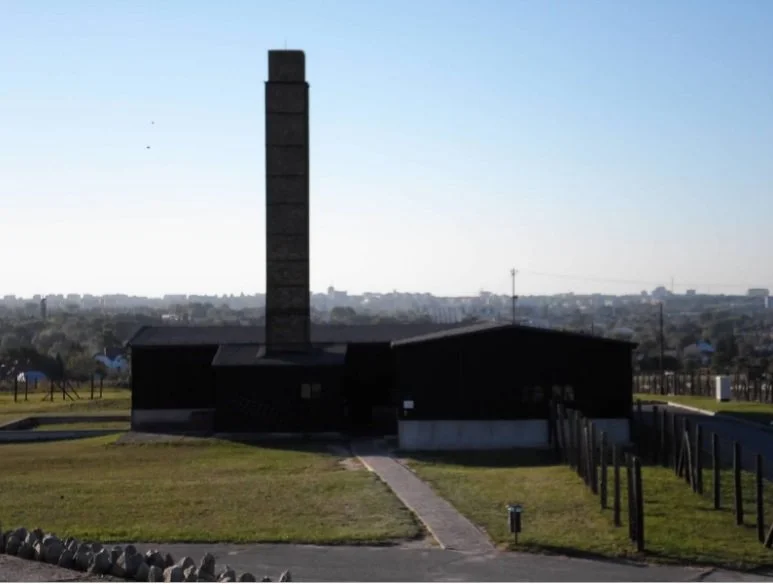Why does the Majdanek Death Total Keep Shrinking?
The number of victims from the Majdanek Death Camp has been a source of controversy over the years. When the Red Army initially liberated the camp, the Russians estimated that between 1.5 and 1.7 million people were victims at the camp. This is almost certainly a high estimate.
But in recent years, Polish historians have revised the number to just 78,000 Jewish deaths at Majdanek.
Majdanek, located in Lublin, eastern Poland, is an extremely large concentration camp with gas chambers and a crematorium and killing fields all still visible to this day. It also had a system of sub-camps like the other KL camps in eastern Poland.
The Aktion Erntefest killings, which took place on November 3-4, 1943, are not included in most of the historical estimates of how many Jews were murdered at the camp. On November 3, 1943, an estimated 18,000 Jews were murdered at the Majdanek killing fields. At two Majdanek sub-camps, in the very same aktion, 16,000 Jews were murdered at Poniatowa and 10,000 Jews were murdered at the Trawniki. All of these Jews were buried in killing fields or ditches in southeastern Poland. Additionally, smaller numbers of Jews at Krasnik camp (including Budzyn), Milejow, and Naleczow were also murdered in November 1943.
In the book "Majdanek" by Jozef Marszalek, the author notes that the prisoners at Majdanek were from 28 countries: Albania, Austria, Belgium, Bulgaria, China, Czechoslovakia, Denmark, Estonia, Finland, France, Germany, Great Britain, Greece, Holland, Hungary, Italy, Latvia, Lithuania, Norway, Poland, Romania, Spain, Sweden, Turkey, the USSR, the United States of America, and Yugoslavia. Marszalek wrote that Polish citizens were 59.8% of the total, followed by citizens of the USSR at 19.8%, Czechoslovakia at 13.3%, the German Reich at 4% and France at 1.7%. All the other countries put together accounted for 1% of the total. There were a total of 54 ethnic groups represented among camp prisoners, including 25 different ethnic groups from the Soviet Union and four ethnic groups from Yugoslavia. According to this book, the actual names of 47,890 prisoners are known, including 7,441 women.
Immediately after the liberation of Majdanek, the Illustrated London News published photographs of the camp, saying that this was "irrefutable proof of the organized murder of between 600,000 and 1,000,000 helpless persons at the Majdanek Camp near Lublin." The same newspaper also stated that "Prisoners too ill to walk into the camp were dragged alive to the furnaces and thrust in alongside the dead."
In 1948, the Main Commission for the Investigation of Nazi Crimes in Poland published a report which said that the number of deaths at Majdanek was 360,000. However, most of the research files have never been released and some of them are stored within the former Soviet Union.
According to the 1998 Majdanek Museum guidebook, the total number of deaths at Majdanek was around 234,000. This number developed from research by Dr. Czesaw Rajca, a former member of the Majdanek Museum staff; it was based on the number of arrivals (300,000) minus the number of prisoners who escaped, were transferred, or were released.
The Hoefle Telegram, a document containing detailed statistics on the 1942 killings of Jews in the extermination camps of Belzec, Sobibor, Treblinka, and KL Lublin-Majdanek, says that already by December 1942, 24,733 Jews were murdered at Majdanek camp.
At the Dusseldorf trial of the Majdanek war criminals, the West German government charged the Nazis with the murder of no less than 200,000 people at the camp. Historian Martin Gilbert wrote, "Between 300,000 and 350,000 people were murdered here in Majdanek over a period of three years."
Calculations from reliable sources show that at least 135,000 Jews were transported to Majdanek camp. However, this does not include nearly all of the transports, so it is a very low and incomplete calculation of Jewish transports to Majdanek. It also doesn't take into account the Majdanek sub-camp system. Finally, it is not likely to include the Aktion Erntefest murders of 18,000 Jews on November 3, 1943 because many of those victims may not have been formally 'registered' with Majdanek authorities.
According to Polish historians, approximately 45,000 prisoners were transferred to other camps after being registered at Majdanek and another 20,000 prisoners were released.
Jewish prisoners were never released, so this 20,000 figure absolutely cannot be subtracted to the total number of Jewish prisoners. Therefore, 135,000 (a low estimate on the number of transfers to Majdanek) + 18,400 (Erntefest total victims at Majdanek) - 20,000 = 133,400 Jewish victims at Majdanek. As noted before, this is a low estimate because the transfer list that totals 135,000 Jews is not complete.
Polish historian Tomasz Kranz's estimate of just 78,000 Jewish victims at Majdanek is far too low. The number is over 133,400 Jewish victims at Majdanek.
Return to Facts about the Holocaust and Combatting Shoah RevisionismThe crematorium at Majdanek Death Camp.
